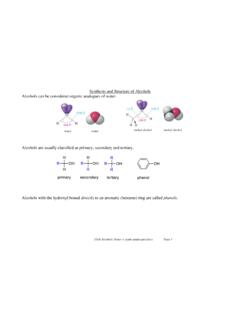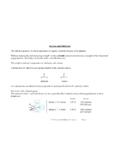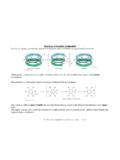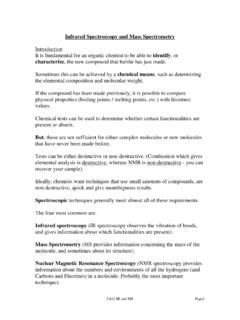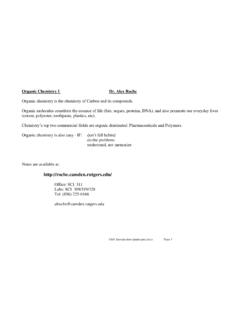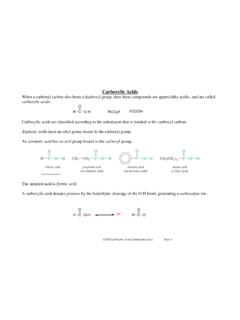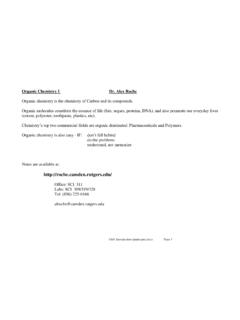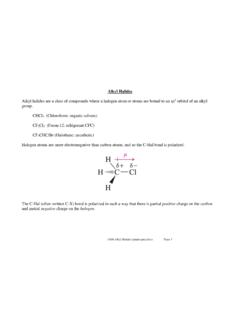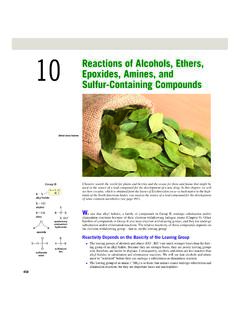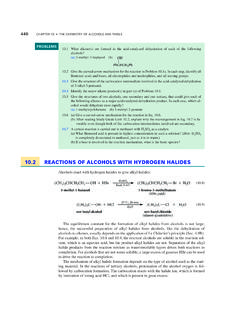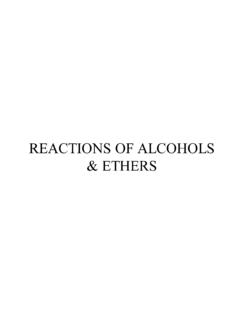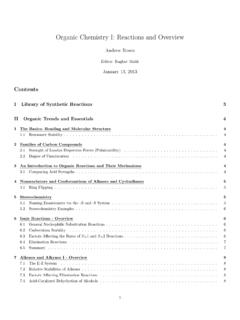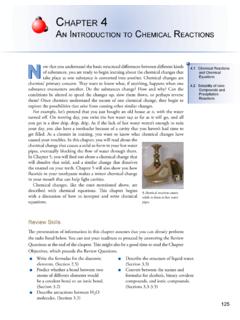Transcription of Reactions of Alcohols - Rutgers University
1 Ch11 Reacns of Alcohols (landscape).docx Page 1 Reactions of Alcohols Alcohols are versatile organic compounds since they undergo a wide variety of transformations the majority of which are either oxidation or reduction type Reactions . Normally: Oxidation is a loss of electrons; Reduction is a gain of electrons. But in organic terms: Oxidation: loss of H2; addition of O or O2; addition of X2 (halogens). Reduction: addition of H2 or H-; loss of O or O2; loss of X2. Neither an oxidation nor reduction: Addition or loss of H+, H2O, HX. Ch11 Reacns of Alcohols (landscape).docx Page 2 Oxidation of Alcohols Primary and secondary Alcohols are easily oxidized by a variety of reagents.
2 Secondary Alcohols The most common reagent used for oxidation of secondary Alcohols to ketones is chromic acid, H2 CrO4. Chromic acid is produced in situ by reaction of sodium dichromate, sulfuric acid and water. Na2Cr2O7 + H2O + 2H2SO4 2 H2 CrO4 + 2 NaHSO4 Ch11 Reacns of Alcohols (landscape).docx Page 3 Mechanism of oxidation The alcohol and chromic acid produce a chromate ester, which then reductively eliminates the Cr species. The Cr is reduced (VI IV), the alcohol is oxidized. Oxidation of Primary Alcohols Primary Alcohols are easily oxidized just like secondary Alcohols , and the INITIAL product of oxidation is an aldehyde.
3 Ch11 Reacns of Alcohols (landscape).docx Page 4 However, the aldehyde can also be easily oxidized to an acid, and this over-oxidation is a practical problem. A common reagent that selectively oxidizes a primary alcohol to an aldehyde (and no further) is pyridinium chlorochromate, PCC. Tertiary Alcohols These are resistant to oxidation because they have no hydrogen atoms attached to the oxygen bearing carbon (carbinol carbon). N:CrO3, HCl(PCC) Ch11 Reacns of Alcohols (landscape).docx Page 5 Other Oxidizing Reagents Potassium permanganate is a cheaper but stronger oxidizing agent, and conditions must be controlled carefully.
4 Thermal dehydrogenation is the cheapest method of oxidation but the high temperatures involved limit the applicability of this method. Reduction of Alcohols Normally an alcohol cannot be directly reduced to an alkane in one step. The OH group is a poor leaving group so hydride displacement is not a good option however the hydroxyl group is easily converted into other groups that are superior leaving groups, and allow Reactions to proceed. OHKMnO4, baseOOHHOHOCuO, 300oC Ch11 Reacns of Alcohols (landscape).docx Page 6 One such conversion involves tosyl chloride, and the formation of a tosylate.
5 These compounds undergo substitution and elimination very easily, often more reactive than alkyl halides. Cyclohexanol will not reduce with LiAlH4, but the corresponding tosylate reduces to cyclohexane very easily. Ch11 Reacns of Alcohols (landscape).docx Page 7 Tosylate Esters Tosylate esters (tosylates) are typically formed from Alcohols with reaction with Ts-Cl and pyridine (py). Tosylate groups undergo a variety of SN2 Reactions . The tosylate is such a good leaving group because it is a stable anion. Ch11 Reacns of Alcohols (landscape).docx Page 8 The tosylate is such a good leaving group because it is a stable anion.
6 Common SN2 transformations of Tosylates: Ch11 Reacns of Alcohols (landscape).docx Page 9 Alcohols and Hydrohaloic Acids Alkyl halides can also be formed by reaction of Alcohols with H-X acids. R-OH + H-Br R-Br + H2O In acidic media, the alcohol is in equilibrium with its protonated form. The OH is a poor leaving group, but OH2+ is an excellent leaving group, and once the -OH is protonated, the molecule may take part in a variety of substitution and/or elimination Reactions . The nature of R determines whether the Reactions proceed via SN1 or SN2 mechanisms. If R is primary alkyl SN2 If R is bulky tertiary alkyl SN1.
7 Ch11 Reacns of Alcohols (landscape).docx Page 10 SN2: SN1: Ch11 Reacns of Alcohols (landscape).docx Page 11 Hydrochloric Acid H-Cl reacts in the same way, although often Zinc (II) chloride (a Lewis acid) is added to help compensate for the lower nucleophilicity of chloride ion. The mixture of HCl and ZnCl2 is called the Lucas Reagent. Secondary and tertiary Alcohols react via the SN1 mechanism with the Lucas reagent. The ZnCl2 coordinates to the hydroxyl oxygen, and this generates a far superior leaving group. Primary Alcohols react in a similar fashion except the free cation is not generated, and the substitution is of SN2 type.
8 Ch11 Reacns of Alcohols (landscape).docx Page 12 Limitations of use of H-X 1) Only works for H-Cl and H-Br 2) Low chemical yields for primary and secondary Alcohols 3) Often observe competing elimination 4) Carbocations can lead to rearranged products Phosphorous Halides Phosphorous halides can convert Alcohols to alkyl halides. 3 R-OH + PCl3 3 R-Cl + P(OH)3 3 R-OH + PBr3 3 R-Br + P(OH)3 R-OH + PCl5 R-Cl + POCl3 + HCl PI3 has to be generated in situ via reaction of iodine and phosphorous. CH3(CH2)14CH2-OH + P/I2 CH3(CH2)14CH2-I This type of reaction does not work well for tertiary Alcohols , and also does not lead to rearranged products.
9 These observations are explained by the reaction mechanism. Ch11 Reacns of Alcohols (landscape).docx Page 13 Mechanism The hydroxyl oxygen displaces a halide (good leaving group) from the Phosphorous. The positively charged oxygen is a good leaving group. The liberated halide performs an SN2 type attack on the back side of the R group. Ch11 Reacns of Alcohols (landscape).docx Page 14 Thionyl Chloride Thionyl chloride (SOCl2) is the usual method of choice for preparing alkyl chlorides from Alcohols . The mechanism is interesting: The hydroxyl oxygen attacks the electrophilic Sulfur, and from the tetrahedral intermediate a chloride is ejected.
10 The chlorosulfite ester rearranges with the breaking of the C-O and S-Cl bonds and the formation of the R-Cl bond and a new S-O bond. When R is secondary or tertiary, the ionization to a cation probably precedes the Chloride attack, whereas if R is primary the process is probably concerted (Bond breaking and forming at the same time). Ch11 Reacns of Alcohols (landscape).docx Page 15 Summary of Best Alcohol to Alkyl Halide Transformations Class Chloride Bromide Iodide Primary SOCl2 PBr3 P/I2 Secondary SOCl2 PBr3 P/I2 Tertiary HCl HBr HI Dehydration Reactions of Alcohols Dehydration of Alcohols requires an acidic catalyst to convert the hydroxyl into a good leaving group this is an equilibrium reaction.
